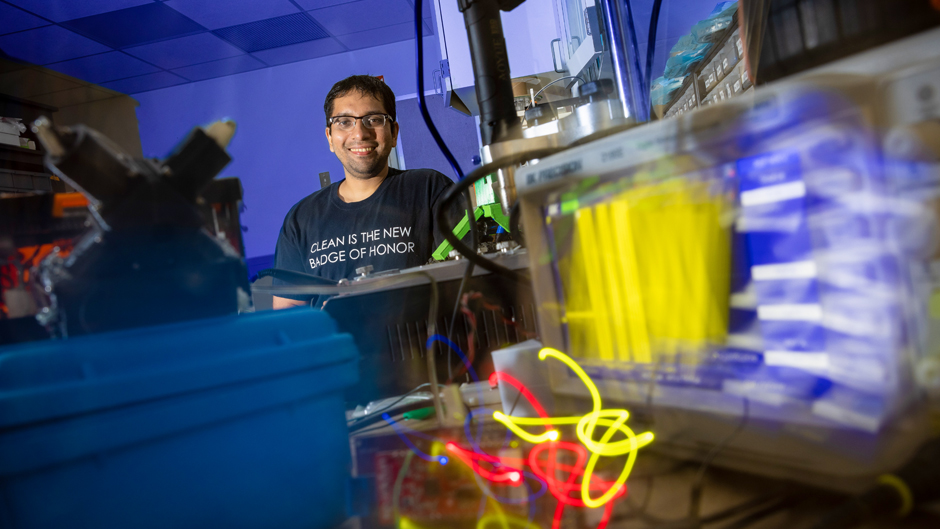Chitvan Killawala and Umer Bakali want to help protect firefighters from a potential threat.
Their strategy to do so does not involve creating a better forcible-entry axe or a thicker face shield but deploying a device no bigger than a USB flash drive.
The two University of Miami graduate students have developed a special sensor capable of detecting the real-time presence of polycyclic aromatic hydrocarbons (PAHs) in the warm zone at structural fires.
A class of chemicals that result from burning coal, oil, gas, wood, garbage, and tobacco, PAHs can bind to or form small particles in the air. In laboratory animals, they are known to cause certain cancers.
Scientists using bulky instruments like mass spectrometers, which require industrial compressed gas cylinders, have measured levels of PAHs in samples in laboratory settings. But deploying such large devices in the field to test for the presence of the chemical is not practical, according to Bakali, a doctoral candidate in biochemistry and molecular biology at the Miller School of Medicine.
“As a consequence, there’s very little solid evidence on the levels of PAHs firefighters are exposed to, particularly inside the warm zone of an active fire scene where team staging activities occur and where they aren’t suited up in personal protective gear. So, our sensors help fill a void,” said Killawala, a doctoral student in biomedical engineering, who started developing the special sensor about two years ago.
He and Bakali used small commercially available sensors designed to measure vinyl chloride, benzene, and other chemicals. “We tweaked their parameters a bit so that we could test for polycyclic aromatic hydrocarbons,” Bakali explained. “The PAHs interact with the sensor and cause a voltage drop, basically a dip in the way that the sensor reads. And that gives us a readout that we can compare to a baseline when there are no PAHs present.”
To test the effectiveness of their sensor, the two graduate students had to find a way to position it close enough to a fire without putting themselves at risk. So, they purchased a miniature remote-controlled monster truck from a hobby store, modifying its exterior and mounting their sensor on its top.
Then, during controlled live burns at fire-training facilities in Miami-Dade, Broward, Palm Beach, and Pinellas counties, they drove their modified mobile rover into the warm zones of structural fires. The sensors, which render a readout in just a few seconds, recorded elevated levels of PAHs, providing evidence that firefighters would be wise to don protective gear in the warm zone as a precaution.
“This was a way to get our analytics out into the field in a way that integrates seamlessly with the firefighter,” said Bakali, who is part of Sylvester Comprehensive Cancer Center’s Firefighter Cancer Initiative.
He and Killawala are modifying their sensor to make it more effective and are planning further testing at fire academies such as the City of Miami’s Fire-Rescue Training Center in Coconut Grove.
Researchers from multiple areas—among them, the Department of Chemistry in the College of Arts and Sciences, the Miller School’s Department of Public Health Sciences, and the Dr. John T. Macdonald Foundation Biomedical Nanotechnology Institute—have assisted Killawala and Bakali in their project.
They envision their sensor being integrated into the gear firefighters carry, allowing them to measure levels of PAHs at command posts in the warm zone. “Another avenue is just to deploy it in fire stations to measure the concentration of PAHs in the air,” Bakali said.
Firefighters with whom the two graduate students collaborated are optimistic about the sensor’s potential, according to Killawala. “And that’s actually the most exciting part of what we’re doing,” he said. “We see how much they value our data. So, that’s a huge motivating factor for us. This could help inform changes in policy and lead to better occupational safety.”

